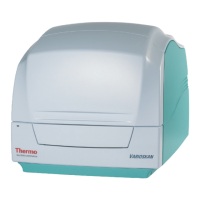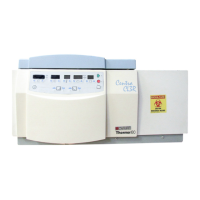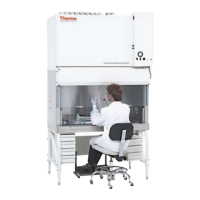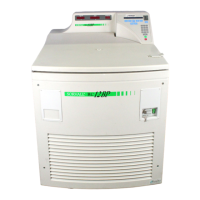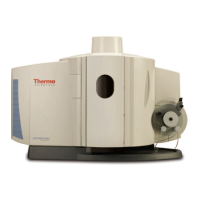4
Ion Transmission and Mass Analysis
Mass Analyzers
Thermo Scientific Orbitrap Fusion Series Hardware Manual 39
As previously mentioned, stable ion trajectories within the Orbitrap analyzer combine axial
oscillations along the z axis with rotation around the central electrode and vibrations in the
radial direction (Figure 25). For any given mass-to-charge ratio, only the frequency of axial
oscillations is completely independent of the initial ion parameters, whereas rotational and
radial frequencies exhibit strong dependence on the initial radius and energy. Therefore, ions
of the same mass-to-charge ratio continue to oscillate along the z axis together, remaining
in-phase for many thousands of oscillations.
In contrast to the axial oscillations, the frequencies of radial and rotational motion vary for
ions with slightly different initial parameters. This means that in the radial direction, the
dephasing of ions is faster than in the axial direction, and the process occurs in a period of
only 50–100 oscillations. After this, the ion packet of a given mass-to-charge ratio assumes the
shape of a thin ring, with ions uniformly distributed along its circumference (Figure 27).
Because of this angular and radial smearing, radial and rotational frequencies cannot appear in
the measured spectrum. Meanwhile, axial oscillations persist, with axial thickness of the ion
ring remaining small compared with the axial amplitude. Moving from one half of an outer
electrode to the other, this ring induces opposite currents on these halves, which creates a
signal detectable by differential amplification.
Figure 27. Approximate shape of ion packets of different m/z after the voltages stabilize
Linear Ion Trap Mass Analyzer
The Orbitrap Fusion Series MS contains a dual-cell, two-dimensional LIT mass analyzer that
consists of a front transfer lens (TL1), a high pressure LIT cell, a center transfer lens (TL2), a
low pressure LIT cell, and a back transfer lens (TL3) (Figure 28). The front, center, and back
transfer lenses are metal plates with a circular hole in the center through which the ion beam
passes. These transfer lenses provide conductance limits.

